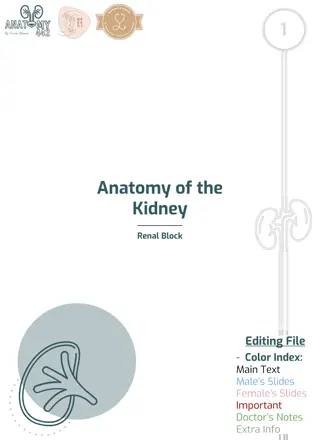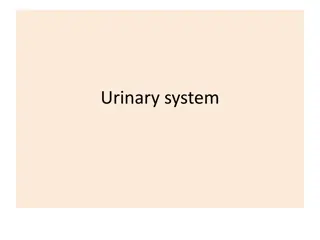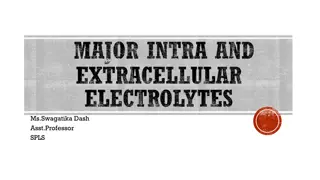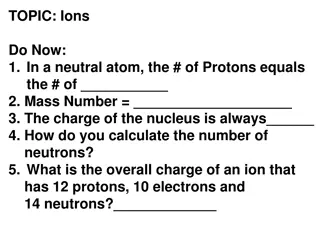Understanding Electrolytes and Their Imbalances: Essential Information
Electrolytes are crucial chemicals that regulate various bodily functions, including nerve and muscle activity, hydration, and tissue repair. Imbalances in electrolyte levels can arise from various factors and conditions such as congestive heart failure, diabetes, dehydration, and intense physical activity. Recognizing and managing electrolyte imbalances are critical for maintaining health and preventing complications. Different populations, from children to athletes, are susceptible to these imbalances for distinct reasons. Awareness of the causes and effects of electrolyte disruptions is vital in healthcare practice.
Download Presentation

Please find below an Image/Link to download the presentation.
The content on the website is provided AS IS for your information and personal use only. It may not be sold, licensed, or shared on other websites without obtaining consent from the author. Download presentation by click this link. If you encounter any issues during the download, it is possible that the publisher has removed the file from their server.
E N D
Presentation Transcript
Electrolytes Asst. Prof. Dr.Huda Jaber PhD Clinical biochemistry Dr.huda.jw@uomustansiriyah.edu.iq
What are electrolytes? Electrolytes are chemicals that conduct electricity when mixed with water. They regulate nerve and muscle function, hydrate the body, balance blood acidity and pressure, and help rebuild damaged tissue. The muscles and neurons are sometimes referred to as the electric tissues of the body. They rely on the movement of electrolytes through the fluid inside, outside, or between cells. The electrolytes in human bodies include: sodium potassium calcium bicarbonate magnesium chloride phosphate For example, a muscle needs calcium, sodium, and potassium to contract. When these substances become imbalanced, it can lead to either muscle weakness or excessive contraction. The heart, muscle, and nerve cells use electrolytes to carry electrical impulses to other cells
Electrolyte imbalances can occur due to hundreds of factors, none of which line up in neat, tidy queues. Look at a few of the most common examples: Patients suffering from congestive heart failure often end up as rebound hospitalisations due to abnormal sodium and potassium levels. A grandmother with diabetes or hypertension may eventually find herself on the business end of a calcium or magnesium imbalance. The toddler with explosive diarrhoea and the elite Australian athlete, otherwise wildly unalike, both routinely find themselves on the business end of electrolyte imbalances. A proper understanding of these imbalances is essential for current management and future prevention.
Facts: Electrolyte imbalances occur across many different diagnostic categories. In Australia, harsh summer environmental exposure, with resulting dehydration, is just one example of a potential root cause; sadly, more Australians are killed from the ill-effects of heatwaves than all other natural hazards, combined. This is just potential cause, however. There are hundreds of other root causes for fluid and electrolyte imbalances, including: In children: a leading cause of dehydration and electrolyte imbalance in children is acute gastroenteritis, a disorder which can be effectively treated with oral rehydration. elevated risk of dehydration and electrolyte imbalance is a diminished thirst response. In the older adult: one of the primary reasons older populations are at an
In the athlete: Electrolyte imbalances during exercise come from multiple sources. Strangely, the muscles doing work do not lose water content during exercise; rather, the muscles dehydrate during the immediate post- exercise recovery period, presumably in an effort to restore plasma volume and to stabilise the cardiovascular system. Many electrolyte imbalances self-correct without any ill- effects. A simple drink of water can correct others. However, electrolyte imbalances can be much more than just a nuisance they can cause severe complications when left untreated. It is important for practitioners to correctly test for and diagnose electrolyte imbalances in order to treat them in an appropriate and timely fashion
What is an Electrolyte Imbalance? Put simply, electrolytes are naturally occurring minerals with an electric charge. They exist in the human body and they are also present in food and fluids we ingest every day. Potassium, magnesium, and sodium are several commonly known electrolytes, but they are not alone; calcium and phosphate also play critical roles. These electrolytes serve crucial functions in the body such as keeping water in balance, regulating the body s base pH levels, and moving nutrients and waste to and from cells
Electrolyte Imbalance Symptoms Electrolyte imbalance can be a marker of many common diseases and illnesses. Assessing a patient for electrolyte imbalance can give practitioners an insight into the homeostasis of the body and can serve as a marker or proxy for the presence of other illnesses. Practitioners can use physical examination, ECGs, serum electrolyte levels and pathologic signs as methods to assess for electrolyte imbalance. Certain symptoms can even point to a specific electrolyte that is out of balance in a patient. For example, confusion is a common symptom of hypocalcaemia.8 By using the aforementioned examination techniques, practitioners can pinpoint which electrolytes are out of balance and thus craft a more effective treatment plan for the patient. There are many different symptoms of electrolyte imbalance that can present themselves in a patient.
Some Common Electrolyte Imbalance Symptoms are: Dyspnoea Fever Systemic deterioration Confusion Oedema Rales Tachycardia Atrial fibrillation Vomiting Abdominal pain
What Causes an Electrolyte Imbalance? Dehydration does not occur at some standardised setpoint; it is caused by consuming too little fluid for the present needs of the body. This can happen by either decreased consumption or outside factors that cause the body to require more water than normal. When the body becomes dehydrated, certain symptoms can arise such as dry mouth or increased thirst. However, these are not universal indicators of dehydration. In fact, they may not be clinically useful for diagnosing dehydration. filtration systems do not operate normally electrolytes no longer function as they should. Abnormal electrolyte levels can occur anytime the body s fluid levels fluctuate outside of norms such as after serious burns, vomiting, diarrhoea, and excessive sweating. Infrequently, overhydration can also result in serious repercussions. Certain medicines and dysfunctions of the liver and kidneys can also throw the body s electrolytes out of normal range. Whenever the body is overhydrated or underhydrated or when the body s
Electrolyte Imbalance Risk Factors Some factors that can increase the risk of an electrolyte imbalance in older populations include: Diabetes Hypertension Use of diuretics (which promote fluid excretion by the kidneys) Within these risk factors there is increased risk to those who use certain combinations of diuretics and to those with diabetes. Patients who use both thiazides and benzodiazepines are associated with higher rates of hyponatremia, which in turn, is associated with a higher mortality risk. The use of angiotensin-converting enzyme inhibitors (ACE inhibitors), potassium and calcium supplements and certain hormones, which are classified as potassium-sparing , can also lead to imbalances. Other conditions that can increase the risk of an electrolyte disorder include: Significant burns Significant trauma (such as broken bones) Congestive heart failure Abuse of alcohol (especially long-term abuse) Kidney disorders Diarrhoea or vomiting Heat exhaustion Eating disorders (such as anorexia or bulimia) Thyroid, parathyroid and adrenal gland disorders (such as Addison s disease)
Diagnosing an Electrolyte Imbalance There are several types of tests that can be used to diagnose electrolyte imbalance. Each type of test has its own pros and cons for detecting various types of imbalances. Here are just a few of the ways practitioners test for electrolyte dysfunction:7 The Anion Gap Blood Test is a blood test that analyses the levels of acid in the blood. This can indicate an electrolyte imbalance, as one of the functions of electrolytes is balancing the pH of the blood. Carbon Dioxide Blood Tests are used to measure CO2 levels in the blood. CO2 in the blood is often in the form of an electrolyte called bicarbonate. Chloride Tests measure the levels of chloride, another electrolyte, in the blood. Sodium Blood Tests analyse sodium levels in the blood, another common portion of an electrolyte blood panel.
Electrolyte Imbalance Treatment Individuals who experience serious symptoms, tachycardia, mental confusion, sunken eyes, reduced elasticity of the skin and/or a loss of consciousness need immediate medical attention. Individuals who dehydrate through exercise or activity can typically look to the electrolyte restoration possibilities of sports drinks. An excellent guide to the use of such sports drinks was put out by Australia s AIS Sports Supplement Framework, an initiative of AIS Sports Nutrition. Between these two extremes is a vast middle ground with some patients requiring rapid though not emergency medical assistance, and some patients self- correcting without ever knowing anything more than that they felt a bit off
Normal Ranges and Disturbances of Common Electrolytes Although there are many trace elements that keep the body healthy, several important electrolytes can severely affect patients when they are either too high (hyper ) or too low (hypo ). Understanding what each electrolyte does, what happens when there isn t enough of one or too much of another, is essential knowledge for nurses and can help guide electrolyte therapy.
Sodium Sodium, or Na a rof elbisnopser si dna ydob eht ni setylortcele tnatropmi tsom eht fo eno si , notialuger retaw dna diufl ot detaler yltsom ,snoticnuf tnatropmi fo rebmun . The normal accepted range for sodium is 134 to 145 mEq/L. Hyponatraemia is considered to be a serum sodium below 134 mEq/L. A common cause of hyponatraemia is water retention due to cardiac or renal or hepatic failure. Other causes of hyponatraemia include some medicines, psychogenic polydipsia (excessive water intake) and syndrome of inappropriate ADH (antidiuretic hormone) secretion, and chronic or severe vomiting and diarrhoea. Common symptoms of hyponatraemia include confusion, agitation, nausea and vomiting, muscle weakness, spasms or cramps. Hypernatraemia is defined as a serum sodium greater than 145 mEq/L. Causes of hypernatraemia can be thought of simply as anything that leads to excessive water loss or salt gain. For example, water depletion or dehydration may be caused by vomiting or diarrhoea. Excessive ingestion of sodium is rare, but the administration of infusions containing sodium such as sodium chloride or sodium bicarbonate may lead to hypernatraemia. Clinical features of hypernatraemia may include fever, irritability, drowsiness, irritability, lethargy and confusion.
Potassium Potassium, or K caidrac dna lateleks sa hcus seussti elbaticxe fo gninoticnuf eht rof elbisnopser si , sevren dna elcsum . The normal range for potassium is 3.5 to 5.0 mmol/L. Hypokalaemia is defined as a serum potassium less than 3.5 mmol/L. A low serum potassium may be caused by decreased oral intake, increased renal or gastrointestinal loss of potassium, or a shift of potassium within the body s fluid compartments (from outside the cell where it should be, to inside the cell. Common clinical features of hypokalaemia range from muscle weakness and ileus (lack of peristalsis), to serious cardiac arrhythmias such as ventricular tachycardias. Hyperkalaemia naht retaerg muissatop mures a , 5.0 tissue damage from burns or trauma, medicines such as potassium sparing diuretics, and most commonly, due to renal failure. Clinical signs of hyperkalaemia include muscle weakness, hypotension, bradycardia and loss of cardiac output, and ECG changes may include peaked T waves and flattened P waves. mmol/L, may be caused by excessive intake,
Magnesium Magnesium, or Mg .snoticartnoc elcsum no tceffe gnorts a sah taht tnemele rehtona si ,The normal plasma range for magnesium is 0.70 to 0.95 mmol/L. Hypomagnesaemia lacinilC .muisengam fo ssol desaercni ro ekatni desaerced yb desuac eb yam ,level muisengam amsalp desaerced a ro , saimhtyhrrayhcat dna sromert elcsum ,muiriled ,ytilibatirri ,noisufnoc edulcni sngis . Hypermagnesaemia is when the level of magnesium in the blood is above the normal range. Fortunately, this is uncommon. Symptoms include poor reflexes, low blood pressure, respiratory depression, and cardiac arrest. This is usually caused by the excessive administration of magnesium and lithium therapy, often in the presence of renal failure.
Calcium Calcium, or Ca ,seslupmi evren lortnoc ot spleh ti sa ydob eht ni tnemele tnatropmi na si , .gnttiolc ni elor a sah dna snoticartnoc elcsumThe serum calcium range should be between 2.20 to 2.55 mmol/L when normal. Hypocalcaemia erar ylevtialer si ,doolb eht ni slevel muiclac mures wol fo ecneserp eht , ,esaesid dioryhtarap ,revewoH .etylortcele siht rof riovreser a sa tca syawla senob eht esuaceb ,ycneicfied D nimativseptic shock and acute pancreatitis can cause this problem. Some symptoms include tetany (involuntary muscle contraction), mental changes and decreased cardiac output. Hypercalcaemia dioryhtarap morf sesira niaga ,doolb eht ni muiclac fo slevel detavele , ,aesuan edulcni ecnalabmi etylortcele fo mrof siht fo sngiS .seussi D nimativ dna smelborp ecnabrutsid latnem dna ssenkaew ralucsum ,airuylop ,gntiimov .
Phosphate, or P .ydob eht tuohguorht snoticnuf lareves ni desu etylortcele na si , nsi ecnalabmi etahpsohp a hguohtlA t as well known as some of the other imbalances, it can still cause problems with your patient s condition . The normal range of phosphate in the plasma is generally between 0.8 to 1.3 mmol/L . The signs and symptoms of either abnormal reading are usually subtle. For hypophosphataemia lamron eht woleb era doolb eht ni etahpsohp fo slevel nehw , amoc dna ,eruzies ,eruliaf traeh ,ssenkaew elcsum edulcni yllareneg smotpmys eht ,egnar . It may be caused by vitamin D deficiency, hyperparathyroidism, or alcoholism. Hypophosphataemia may also be present, in addition to other electrolyte disturbances, in re-feeding syndrome, which is associated with the commencement of total parental nutrition (TPN) Hyperphosphataemia evoba era doolb eht ni etahpsohp fo slevel nehw , ro cilobatem dna ,seussi dioryhtarap ,esaesid yendik yb desuac eb nac ,egnar lamron eht sisodica yrotaripser . Symptoms are usually not present, and they are related to hypocalcaemia. Renal patients can experience hardened calcium deposits when this condition goes untreated.
Electrolyte Imbalance Complications Improper management of electrolyte imbalances can worsen the baseline condition. For example, overly aggressive treatment of hypo- and hyperkalemia can cause cardiac arrhythmias. imbalance include: Arreflexic weakness due to hypermagnesemia, hyperkalemia, and hypophosphatemia Epileptic encephalopathy's from hypomagnesemia, dysnatremias and hypocalcemia Visual loss due to intracranial hypertension caused by respiratory acidosis Quadriplegia due to hypermagnesemia Central pontine myelinolisis due to mistreatment of hyponatremia Some additional complications that can be caused by electrolyte























